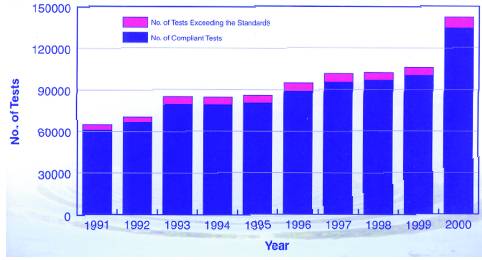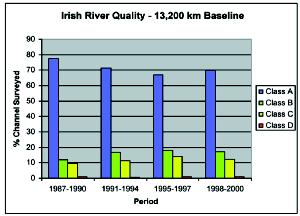| 2002 |

|
YEAR BOOK |
ENVIRONMENTAL PROTECTION AGENCY
|
Drinking water in Ireland
|

Of those tests that exceeded the standards (5.7% of samples), the parameters for coliforms, colour, iron and manganese are the most frequently exceeded. Exceedances of the coliform standard (38.7%) were by far the most frequently found parameters in excess of the standards. A comparison of all exceedances in 2000 as compared to 1999 indicates that the change in compliance rate has improved for heavy metals (0.44%), nitrate (0.23%), odour (1.16%), pH (0.02%), taste (1.21%) and turbidity (1.54%): however, the compliance rate has decreased during the same period for aluminium (0.79%), ammonium (0.78%), coliforms (2.94%), colour (0.18%), iron (0.36%), manganese (0.13%) and fluoride (0.41%).
An examination of the coliform data reveals that there were 1,712 total coliform exceedances in group water schemes as compared to 1,333 in public water supplies. Not all coliforms are of faecal origin and analysis indicates that there were 510 samples containing faecal coliforms in public water supplies and 1,206 samples containing faecal coliforms in group water schemes.
In general, the quality of drinking water produced by sanitary authorities remains high (96.7% compliance) and is far superior in comparison to group water supplies (70.8% compliance).
New technologies are being introduced to treat group water supplies, with this effort being underpinned by the allocation of �533 million under the National Development Plan 2002�2006.
The EPA undertook a series of audits in 2001 to determine the extent to which results in breach of the standards are being investigated and remedied by the sanitary authorities. The EPA is not satisfied that the informal procedures in place are adequate for dealing with all exceedances of the standards and recommends that Local Authorities prepare documented procedures.
Contact: Avril Boland, EPA HQ,
PO Box 3000, Johnstown Castle Estate, Co. Wexford;
Tel: 053-60600.
Water Quality in Ireland 1998�2000

Some 85.5% of the 304 lakes surveyed were classified as oligotrophic or mesotrophic, and thus satisfactory in terms of water quality, compared with 81% of the 120 lakes surveyed in the earlier period. Some 44 lakes were classified as eutrophic or hypertrophic due primarily to diffuse agricultural sources, but some also due to point source municipal and industrial discharges. A reduction in chlorophyll levels in the major Shannon lakes, Loughs Derg and Ree, is believed to be due in part to the introduction of zebra mussels, and partly to a major programme of phosphorus removal at 17 wastewater treatment works. The estuarine and coastal waters survey covered 25 different bays and estuaries. Thirteen were classified as eutrophic, another four potentially so and most of these have been designated as Sensitive Areas under the Urban Wastewater Regulations. Estuaries are generally in good condition but some quite serious problems still exist, with several suffering from organic pollution due to local waste discharges.
The quality of the aquifers sampled in the period indicated some obvious problems, with indications of organic contamination at a relatively high proportion of the sites examined. Some 14% of sites had elevated ammonia concentrations indicating organic contamination, and faecal coliform levels indicating gross contamination were recorded at 36 percent of the 134 sites examined for this latter parameter. High nitrate values were recorded at 19% of the 216 monitoring sites at which nitrate was measured.
The results again point to phosphorus as the main driving force behind the water quality problems experienced. A range of phosphorus sources is identified, including municipal sewage treatment works and farm losses.
Contact: Martin McGarrigle, EPA Regional Inspectorate,
John Moore Road, Castlebar, Co. Mayo; Tel: 094-21588.